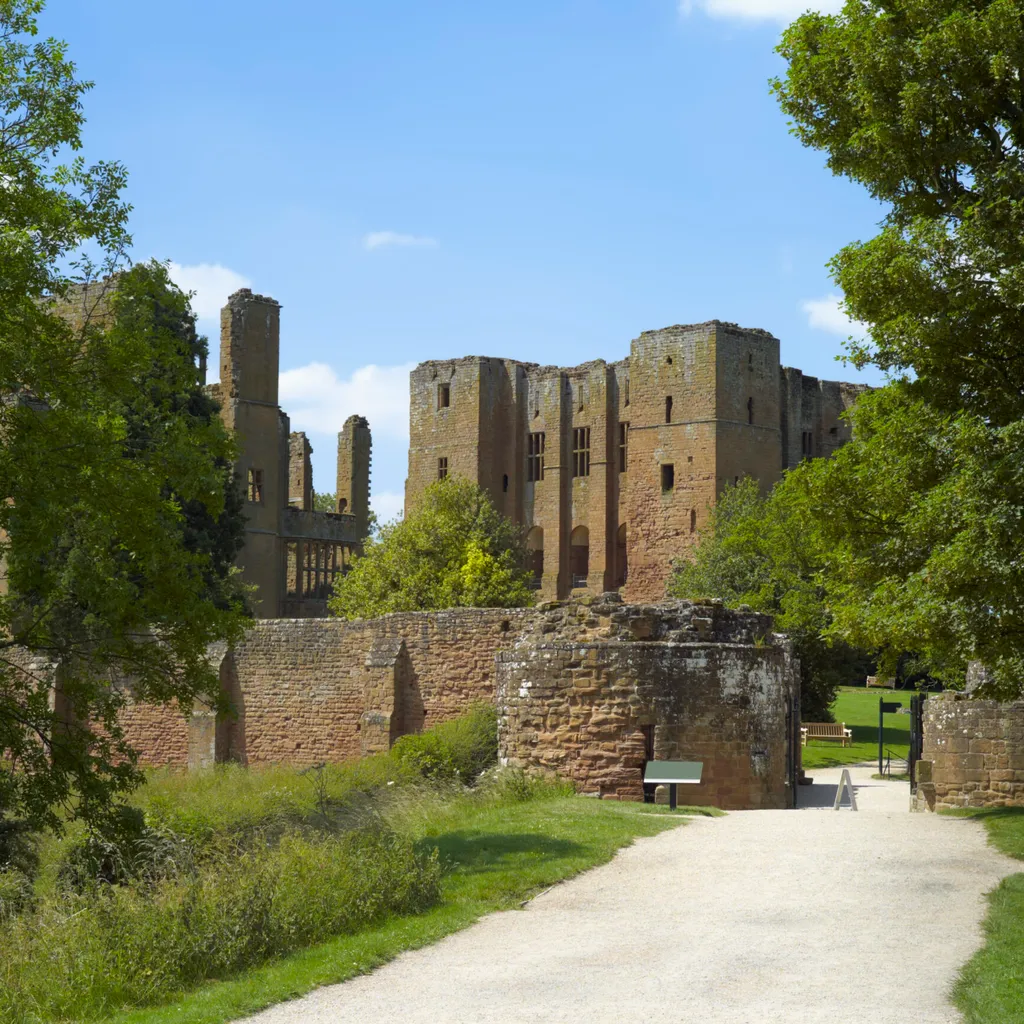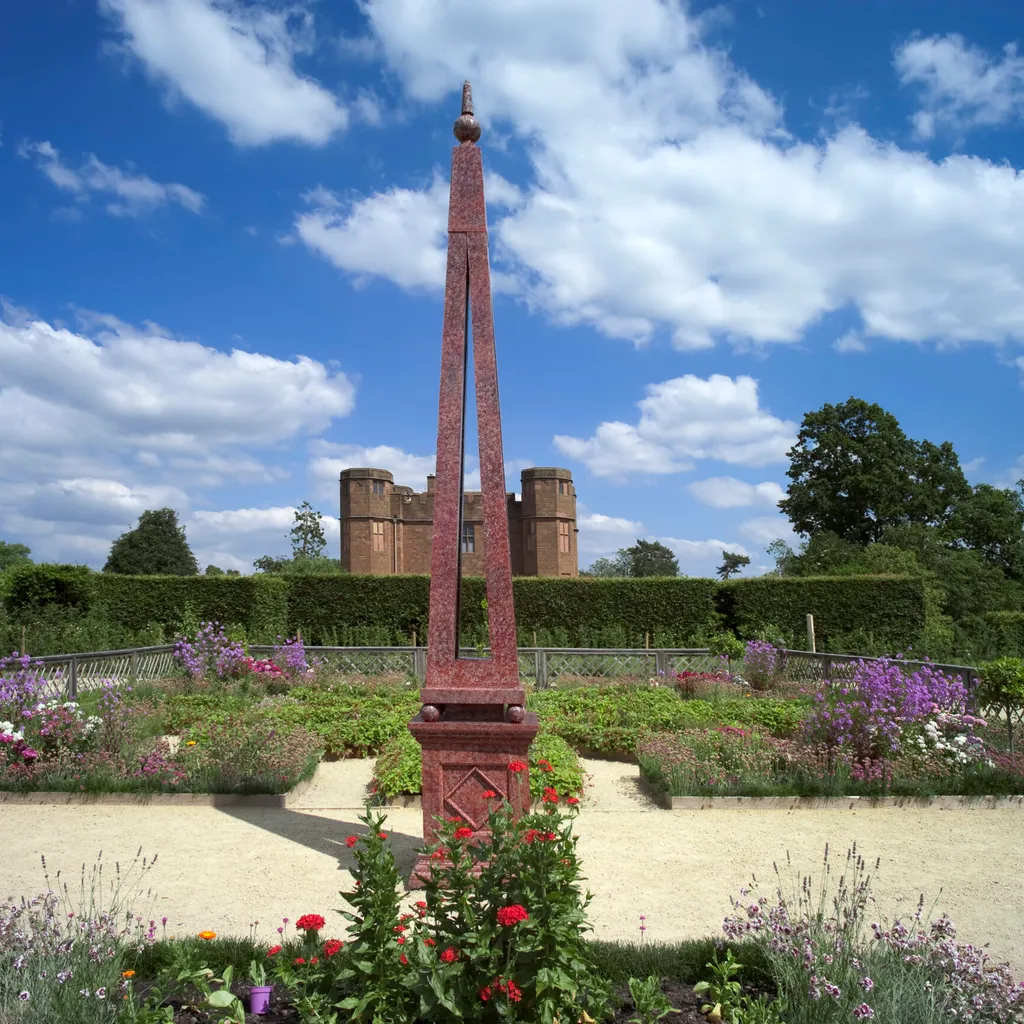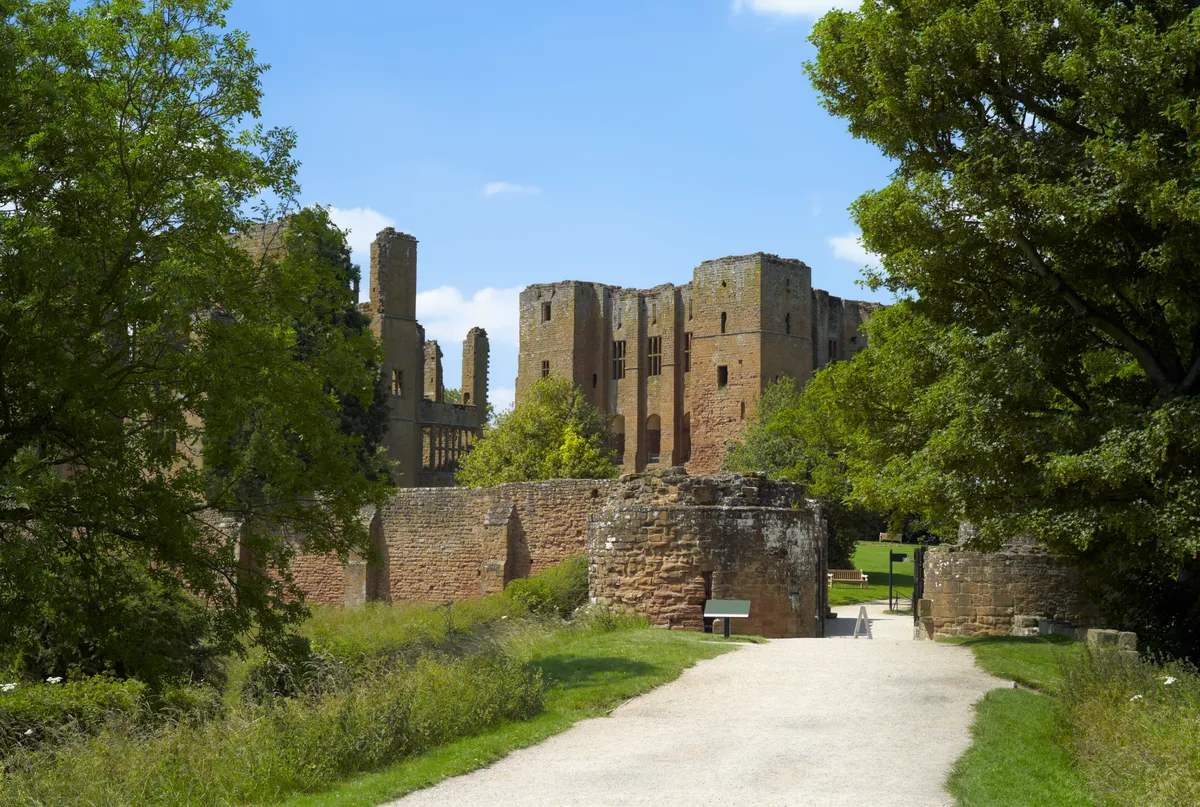Kenilworth seems destined to be forever tied to the enigmatic love story of Elizabeth I and Robert Dudley, Earl of Leicester. Rumours, gossip and tittle-tattle were constantly swirling around the nation’s most eligible young lady and the ‘singular well-featured’ earl.
Castle, palace, priory, great house – over the centuries Kenilworth has claimed all these labels. Read on to find out more.
Where is Kenilworth Castle?
Located in the town of Kenilworth in Warwickshire, England.
The castle is situated approximately 6 miles (10k) north of Warwick and around 5 miles (8k) south-west of Coventry.
When was Kenilworth Castle built?
The initial construction of Kenilworth Castle began in the early 12th century, around 1120, under the direction of Geoffrey de Clinton, a royal official.
The castle was initially a Norman keep, but over the centuries, it underwent expansions and renovations.

Who built Kenilworth Castle?
One of the most significant periods of construction occurred during the reign of King John in the late 12th century.
Additional enhancements and additions were made during the reign of King Henry III. The castle further evolved under the ownership of notable historical figures, including Simon de Montfort.
The castle was given to Dudley by Elizabeth in 1563, by which time it had become one of England’s most impressive strongholds.
Its new owner immediately set about turning it into a palace fit for his queen. Successfully, too – on one occasion, Elizabeth stayed at Kenilworth for 19 days of feasting and revels.
Who destroyed Kenilworth Castle?
Suffering the same fate as Corfe, the castle was slighted after the Civil War and has remained a picturesque ruin ever since, complete with Tudor towers and mouldering keep.
Kenilworth Castle and its Elizabethan Garden

Come in late spring and you can drift around Kenilworth’s recreated Elizabethan Garden, admiring the first flush of blooms and reading out passages from Sir Walter Scott’s novel Kenilworth, a highly fictionalised account of the Elizabeth and Dudley story.
Who lived at Kenilworth Castle: A history by Julia Bradbury
Originally, it was part of Henry I’s royal manor of Stoneleigh.
In the early 12th century, the king granted it to his chamberlain Geoffrey de Clinton who divided it in two, giving one part to an Augustinian Priory. For the next three centuries it was passed back and forth between the crown and various noble families, but the 1266 siege of Kenilworth Castle is one of the most notable events in its history.
Simon de Montfort had become a leading rebel against King Henry III during the Barons’ War – Kenilworth had been de Montfort’s headquarters, and it was there that his loyalist supporters retreated following his death at the Battle of Evesham.

The king was determined to flush the rebels out and began a siege of the castle that lasted for an extraordinary six months. Kenilworth was never stormed – testament to its military might.
It was difficult to infiltrate due to its unique structure – the castle had a dam to the south, and behind that an artificial lake stretching around to the west. There were also a series of ditches and pools along the east side.
You will be able to see this for yourself once you pass Mortimer’s Tower at the end of the long castle drive. You could either take a 15-minute walk around the external castle walls, or climb the Strong Tower for panoramic views of the countryside beyond.
The royal forces used stone-throwing devices and wooden towers to little avail. They even tried to use barges to cross the water barriers but again they were unsuccessful.
The siege only ended after disease and famine weakened those within the 1,200-strong garrison. The rebels eventually accepted the Dictum of Kenilworth, giving the chance to buy back their estates.
Luxurious country pad
During the Elizabethan period, the castle was granted to Elizabeth I’s favourite, Robert Dudley, Earl of Leicester.
The Earl converted the castle into a great house and spent a fortune transforming it into a luxurious palace fit to receive his queen and her court; sumptuous apartments hung with rich tapestries, huge fires and a dancing chamber (the queen loved to boogie).
He even created a private garden with a stunning terrace – he wanted the grounds to be as magnificent as the interiors he had fashioned for her.
There has been much speculation that relationship between the Virgin Queen and Dudley was more than platonic. On one of her visits (her fourth and final) she stayed for 19 days – the longest she had ever stayed at a courtier’s house.
Ghosts among the ruins?
These days, what’s left of Kenilworth is in the safe hands of English Heritage. The distinctive red sandstone ruins are crackling with history and there are stories of spooky sightings and goings-on.
Monks, soldiers and running women have all been spotted, felt or smelt at some stage. And you too could have a ghostly encounter as you explore the kitchen, Great Hall and keep. There are all sorts of spooky events planned over the winter, from a Christmas ghost tour to a Halloween overnight stay.
There’s no furniture, so those who are brave enough must be prepared to rough it a bit: think camp beds and scary stories. There’s no four-poster luxury here anymore, but a great atmosphere among the ruins. They don’t want to scare the little ones either – children have to be over eight.
You never know, one of the barons might make an appearance. If not, or being spooked isn’t your kind of thing, then why not take a stroll through the revived Elizabethan Garden.
It was lost to the world for more than 400 years but re-opened in 2009 – as a reward, treat yourself to a delicious home-made cake in the Tudor stables that now house the tearoom. But watch out, a phantom little boy has been spotted there.
Useful Information
How to get to Kenilworth Castle
By car from London, take the M40 to J15, taking the A46 towards Kenilworth town centre and follows signs for the castle and B4103.
The nearest train stations are Coventry and Leamington Spa. The castle is a 10-15 minute walk from Abbey Fields Park and the Clock Tower stops.
Opening times
Visit English Heritage for opening times and prices. For free entry become a member and enjoy unlimited access to all their properties, or book non-member tickets to visit Kenilworth Castle.
Where to stay and eat near Kenilworth Castle
- The Clarendon Arms: A family friendly pub opposite the castle, offering good quality, reasonably priced food and selection of beers.
- 61 Warwick Road: A boutique hotel dating from the 16th century, with its own swish cocktail lounge. Book room six for some original oak beams. Check availability and book a room on TripAdvisor.
Looking for more inspirational Days Out?
For other romantic ruins, check out our guide to Corfe Castle or explore the nearby home of Britain’s most famous writer, William Shakespeare, in Stratford-upon-Avon. And, if you're looking for other castles to visit, check out our expert guides to Norham Castle, Northumberland, Stirling Castle, Stirlingshire and Gwydir Castle, Conwy.
